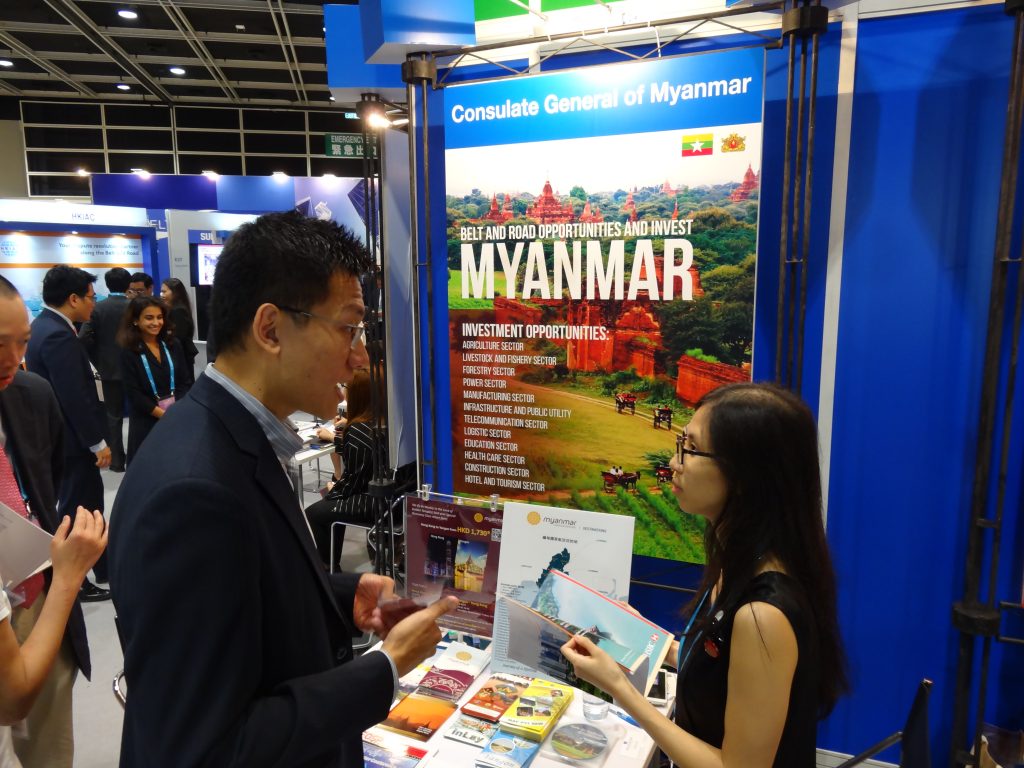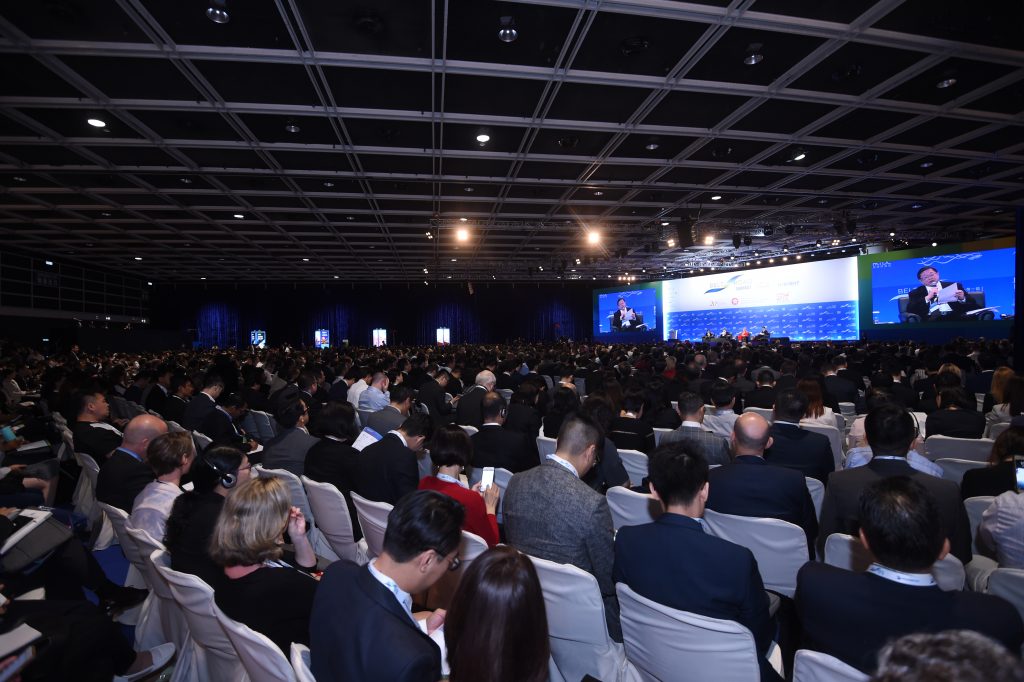Myanmar is where ASEAN, Belt and Road converge
THE unique selling point of Myanmar is that it connects ASEAN, China and South Asia, businesses at the Hong Kong Belt and Road Summit told The Myanmar Times. The Belt and Road Initiative (BRI) is expected to provide the impetus to turn Myanmar into a hub, facilitating trade and transport between the three regions, but the lack of infrastructure means that this advantage does not materialise.
Jointly organised by the Hong Kong government and its trade body, the Belt and Road Summit themed “from vision to action” concluded on September 11. The Myanmar delegation consisted of U Min Thein, director general of the Department of Human Settlement and Housing Development under the Ministry of Construction, representatives from Marga Group, TV operator Sky Net and the Myanmar Licensed Contractors Association (MLCA), among others.
The Myanmar Times sat down with members of the Myanmar delegation who shared their thoughts on the Belt and Road Initiative on September 11.
Risks and infrastructures
U Zaw Naing, managing director of Mandalay Technology, urged a change of mindset for Chinese businesses in order to minimise disruption on communities and the environment. Doing so, he said, would help reduce the risk of widespread communal opposition against China-backed projects.
Chinese investors, engineering companies and contractors need to improve the way they look at projects and the way they work and operate – U Zaw Naing, Mandalay Technology
Tomoaki Yabe, managing director of Thilawa-based Daizen Myanmar, said that the BRI provides the impetus to speed up the country’s infrastructure development. This, in turn, raises Myanmar’s competitiveness as a trading and logistics centre in the region.
“Infrastructure improvement on connectivity is vital for the logistics sector. Improvement on roads and railways, ports and power plants, will definitely reduce the time and cost it takes for delivery and transport. This has huge implications for many sectors,” he observed.
U Aung Khin Myint, chair of Myanmar International Freight Forwarders Association (MIFFA), told The Myanmar Times that the Belt and Road Initiative is a boost for transport and trade logistics sectors.
“There are many risks for us when it comes to the BRI, but the risks can be managed. We need to find a solution to balance the benefits and risks,” he said.
The BRI-led momentum in trade projects is timely, given that the WTO Trade Facilitation Agreement (TFA), which Myanmar has ratified, entered into force in February this year.
“The Belt and Road Initiative is timely because the TFA, which Myanmar ratified, has come into force. The Myanmar government is carefully approaching the issue of WTO-TFA guidelines,” he noted.
The Ministry of Transport and Communications is fully aware about the developments of the BRI, according to U Aung Khin Myint. In particular, initiatives for cross-border transport and logistics are gathering steam in the Greater Mekong Sub-region.
“Myanmar and Thailand are going to sign the Memorandum of Understanding [MoU] on bilateral initial implementation of the cross-border transport facilitation agreement [IICBTA] soon. After that, Myanmar and China will sign the same IICBTA MoU. In addition, the highway between Muse and Mandalay will be upgraded from two lanes to four,” he added.
The chair of MIFFA argued in favour of a multi-modal transport for the Bangladesh-China-India-Myanmar (BCIM) economic corridor. Adopting at least two means of transport connecting Kunming, Mandalay, cities in Bangladesh and Kolkata will be more “effective”.
U Thet Win, MLCA adviser told The Myanmar Times that the organisation signed an MoU with China Real Estate Chamber of Commerce Hong Kong and International Chapter (CRECCHKI) on the same day, hoping to collaborate on developing the real estate sector in Myanmar.

The consulate general of Myanmar has a booth to promote business opportunities in Myanmar as well as to attract international investors at the Belt and Road Summit. Photo: Thompson Chau/ The Myanmar Times
Myanmar’s USP
Tomoaki Yabe stressed that Belt and Road’s blueprint for Myanmar revealed the country’s unique selling proposition (USP) but the hardware and software need to complement each other for the USP to work.
“Myanmar’s role in the BRI’s two economic corridors demonstrates its geopolitical importance in bridging China and South Asia, China and ASEAN as well as ASEAN and South Asia. But this geopolitical USP – i.e. bridging ASEAN, China and South Asia – cannot be realised unless its regional infrastructure is in place.
“Being strategically located, Myanmar is where the Belt and Road ambition meets the ASEAN vision.
“Apart from the hardware, i.e. good roads and railways, the country needs to upgrade its software, such as customs operations, cross-border arrangements, insurance sector, regulations and many more.
“The introduction of bonded warehouse, cross-border logistics pilot scheme, new Investment Law and the pending Companies Act are evidence that Myanmar is taking the rights steps to upgrade its software to position itself as the ASEAN-China-South Asia logistics and trading centre. But the hardware needs a lot of money to be built and there’s a lot to be done. BRI investments will be crucial.
U Zaw Naing agreed with Mr Yabe’s view: the country is where ASEAN and Belt and Road converge. This line has time and again been echoed by politicians and pundits in the country. However, he added that Myanmar cannot afford to rest on its laurels because other countries, such as Vietnam, are well ahead in bridging the regions.
“It is quite a challenge to see how long the window of opportunities currently open for Myanmar will remain open,” he remarked.
The BRI will shape Myanmar’s infrastructure to become a hub between China and South Asia because that is of China’s national interest, according to U Zaw Naing.
“Again, it is China’s utmost interest to develop the Kunming-Kyaukphyu railway, and possibly an elevated highway as well, as the trading and logistics route for western China. This will make up an important component of the BRI and the BCIM corridor. It links China up with the western part of the world without going through the Malacca Straits,” he said, adding that Myanmar may benefit from a significant increase in inflow of FDI and in terms of job creation. But there are concerns regarding land confiscations, environment degradation and impacts on communities.
“In addition, Myanmar is involved in the China-Indochina Peninsula economic corridor, which encompasses many ASEAN countries. This corridor has seen a significant level of infrastructure already established,” he told The Myanmar Times.
Chinese firms displacing others
U Zaw Naing was concerned that Belt and Road is going to help Chinese companies displace Myanmar and international companies in Myanmar.
“We do see such trends. We have concerns that Chinese firms are moving beyond contractor work to become project owners and investors. The general public is worried that Chinese companies will control the ownership of the projects, facilities, real estate, roads, railways and the land of Myanmar.
“There have been complaints that Chinese contractors are bringing in Chinese workers to Myanmar for many projects. We are not talking about only the high-level experts such as engineers or technicians, but also the labour workers. This means that people in the host country, i.e. Myanmar in our case, cannot benefit from the jobs created,” he said.
In contrast, Mr Yabe brushed off concerns that Chinese companies will displace domestic and international firms, as long as Myanmar provides a level-playing field for businesses.
“As our record has shown, Daizen welcomes Chinese businesses, Hong Kong businesses, ASEAN businesses and any investors who are interested to enter into Myanmar.
“The joining of Chinese companies, as in any firms regardless of their origin, surely will raise the competitiveness and hence the quality of services, offering more options for customers, as well as increase the level of investments, given that we have a fair and transparent system,” he responded.

The Belt and Road Summit on September 11 is jointly organised by the Hong Kong government and its trade body. Photo: Supplied
Source: https://www.mmtimes.com/news/myanmar-where-asean-belt-and-road-converge.html


 English
English




